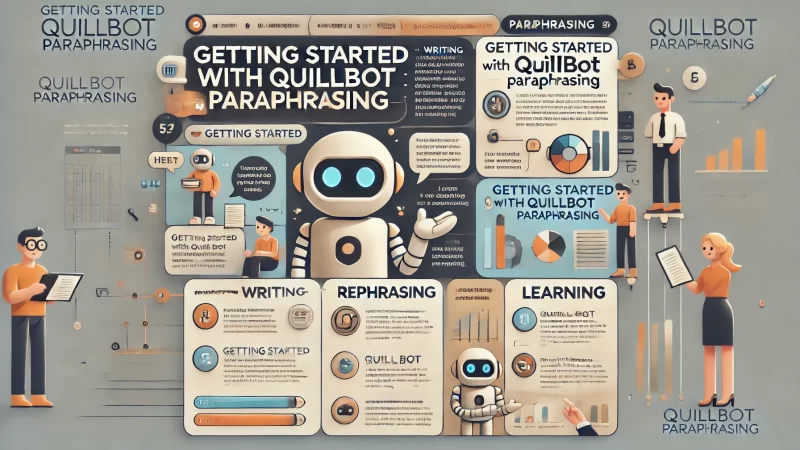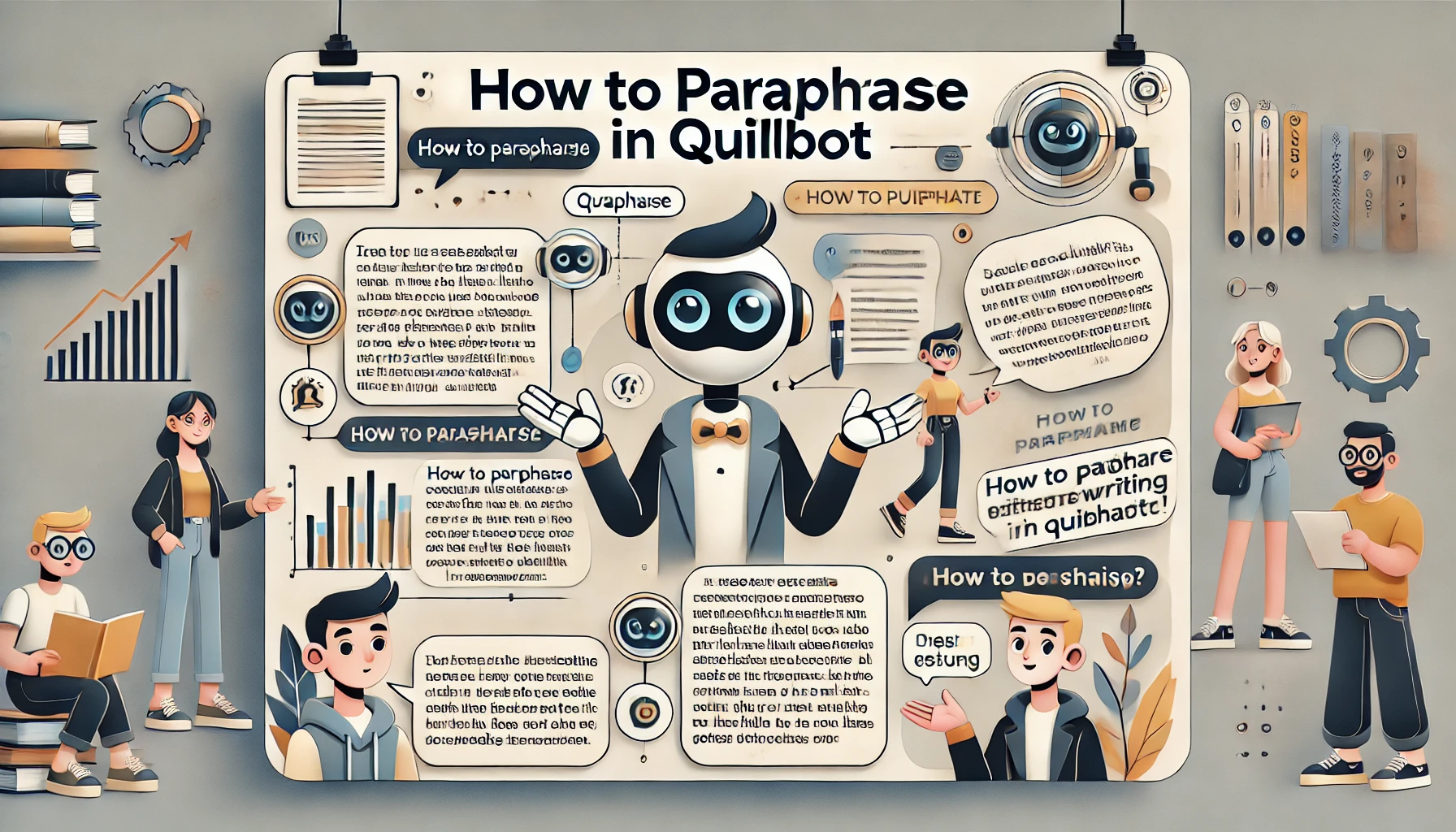Are you looking to enhance your writing by rephrasing content effectively? QuillBot’s paraphrasing tool offers a seamless solution. In this guide, we’ll explore how many words can Quillbot paraphrase in to improve clarity and originality in your work.
Understanding QuillBot’s Paraphrasing Tool
QuillBot’s paraphrasing tool offers an efficient way to rephrase sentences while maintaining the original meaning. This tool is perfect for those looking to improve content clarity or create unique versions of their writing without losing the essence.
What Is QuillBot’s Paraphraser?
QuillBot’s paraphraser is a tool designed to help users rephrase text effectively. By rewriting sentences, it preserves meaning while enhancing readability. Users can paste any text, and the tool swiftly produces a rephrased version, making it invaluable for writers, students, and professionals who need fresh content.
QuillBot’s paraphraser processes text through various algorithms, rewording content without creating awkward phrases. It maintains the tone and context, ensuring the message remains clear. Users find this especially helpful for avoiding duplicate content issues.
Unlike simple synonym replacements, QuillBot’s tool considers sentence structure and grammar, creating fluent, engaging content. This advanced approach ensures that the paraphrased content feels natural and coherent, boosting readability and engagement.
I’ve found that QuillBot’s paraphraser is particularly beneficial when aiming for clarity and creativity. It’s versatile, catering to casual writers and academics alike, enhancing the writing process without sacrificing originality.
Key Features of QuillBot’s Paraphrasing Tool
QuillBot’s paraphrasing tool includes multiple modes, each tailored to different writing needs. From Standard to Creative modes, these options allow users to adjust the level of creativity and precision, ensuring a paraphrased output that aligns with their goals.
Another key feature is the synonym slider, giving users control over word choice. This option enables a tailored level of synonym usage, allowing for subtle changes or more extensive rephrasing to match personal style or specific needs.
One standout feature I recommend is the integration with writing platforms, such as Google Docs. This integration streamlines the writing workflow, making it easy to paraphrase without switching tools, saving users time and boosting productivity.
QuillBot also supports multilingual paraphrasing, widening its accessibility. Writers across different language backgrounds can benefit, creating content in their preferred language without barriers, which is ideal for global users or those working in multilingual settings.
Benefits of Using QuillBot for Paraphrasing
Using QuillBot for paraphrasing helps writers maintain a natural tone, an essential aspect for reader engagement. Its intelligent paraphrasing goes beyond basic rewriting, creating content that feels original and appealing to a broad audience.
QuillBot also contributes to SEO by reducing duplicate content risks. By rephrasing existing text accurately, it ensures the final content remains unique, which helps improve rankings. This makes it a practical tool for bloggers and content strategists aiming to boost site visibility.
I often advise using QuillBot to enhance clarity, as it simplifies complex language. For those working on academic or technical content, this benefit allows for smoother, more digestible content that resonates better with readers.
Another benefit is time-saving. Manually paraphrasing can be tedious; QuillBot streamlines the process, providing quick, high-quality results. This is particularly helpful for professionals on tight schedules who need fast yet effective content rewriting.
Getting Started with QuillBot Paraphrasing

Starting with QuillBot is straightforward, allowing users to quickly explore its paraphrasing capabilities. From creating an account to understanding its interface, the tool is designed for ease of use, welcoming beginners and experienced writers alike.
Creating a QuillBot Account
Creating a QuillBot account is easy and takes only a few minutes. Users can register with an email address or link a social account, gaining access to basic features right away. For those looking to explore premium options, there’s a straightforward upgrade option as well.
Once registered, users have access to QuillBot’s paraphrasing modes and settings. The account setup includes useful onboarding guides, making it easier to start using the paraphrasing tool efficiently. I find that these guides are particularly helpful for first-time users.
Having a QuillBot account also means access to other helpful tools. QuillBot offers more than just paraphrasing, so an account unlocks a range of features for enhanced productivity in writing and content creation.
I advise setting up profile preferences to streamline your workflow. For example, adjusting language settings or selecting default paraphrasing modes can save time, allowing users to get the most out of the tool’s capabilities.
Navigating the QuillBot Interface
QuillBot’s interface is user-friendly, designed with simplicity in mind. Users will notice the main paraphrasing area, where text input and output appear, allowing an intuitive experience that’s suitable for all levels of tech-savviness.
On the left side, you’ll find options for different paraphrasing modes. Selecting a mode is as simple as a click, letting users experiment with various tones and styles, depending on their goals. This flexibility is a key feature I recommend exploring early on.
The synonym slider is another essential tool within the interface. It’s easy to adjust with a quick drag, enabling users to control the depth of paraphrasing. By experimenting with this feature, users can achieve a custom balance between originality and clarity.
I suggest using the interface’s integration features if you frequently work across platforms. With a few clicks, users can link QuillBot to Google Docs, enhancing the tool’s usability by making it accessible within familiar writing environments.
Selecting the Appropriate Paraphrasing Mode
Selecting the right paraphrasing mode is essential for achieving desired results. QuillBot offers modes like Standard, Creative, and Fluency, each serving a specific purpose. Choosing the mode that aligns with your goals can make a big difference in output quality.
Standard mode is ideal for general rephrasing. It maintains the original tone while making slight adjustments for clarity. I recommend this mode for those looking for a balanced approach, keeping text close to its original structure.
Creative mode, on the other hand, takes more liberty with word choices, adding a unique spin to the content. This mode is particularly useful for creative projects or when you want a more distinct version of your text. It adds flair without overhauling the content.
Fluency mode focuses on improving readability. I find it helpful for technical or academic content where complex language needs simplification. It refines the text, enhancing clarity and making it more accessible to a wider audience.
Using the right mode in QuillBot allows users to adapt their writing for various audiences and purposes, providing flexibility while ensuring the rephrased content aligns with the intended tone and style.
Step-by-Step Guide to Paraphrasing in QuillBot
QuillBot’s paraphrasing tool simplifies content rephrasing, offering users a clear path to refining their writing. Here’s a step-by-step guide to help you use QuillBot paraphrase effectively and enhance your content’s quality and readability.
Inputting Text for Paraphrasing
To start paraphrasing in QuillBot, users simply paste their text into the provided input field. This step sets the foundation, allowing QuillBot to analyze and suggest alternative phrasing options that maintain the essence of the original text.
Once text is entered, QuillBot’s system begins processing. I suggest reviewing the initial text to identify areas needing clarity, as this can guide the tool in offering better paraphrasing suggestions. Focusing on unclear sections will yield more relevant results.
QuillBot’s interface makes it easy to paste text directly from any source. This user-friendly feature saves time, especially for those managing large volumes of content. Keeping the process seamless helps users stay focused on enhancing their work.
Users can also type directly into the input field if they want a more hands-on approach. This option is useful for drafting on the go, making QuillBot a versatile tool for content creators seeking flexibility.
Adjusting Synonym Settings for Desired Output
After entering the text, adjusting the synonym settings helps refine the paraphrased result. QuillBot offers a slider to control how much synonym variation is applied, giving users the flexibility to match their preferred writing style.
A higher synonym setting results in more extensive rephrasing, introducing fresh wording throughout the text. This option is ideal when aiming to create a unique version that differs significantly from the original, a helpful feature for SEO.
Lowering the synonym level, on the other hand, keeps the paraphrasing closer to the original text. I recommend this for users who want minor tweaks without altering the content’s meaning or tone, preserving the original flow of ideas.
Experimenting with the slider is a great way to see how QuillBot adjusts phrasing. I often suggest trying different settings to discover the right balance, as this can significantly impact the final output’s readability and appeal.
Reviewing and Editing Paraphrased Content
Once QuillBot generates the paraphrased text, it’s crucial to review the output carefully. This step ensures that the content meets your intended tone and clarity, allowing you to make minor edits to enhance its effectiveness and flow.
I advise reading through each paragraph, paying attention to any phrases that may feel out of place. Sometimes, minor adjustments can help the paraphrased content better align with your original message, making it more relatable and impactful.
QuillBot’s suggestions are usually accurate, but a quick edit may be necessary to fit your personal style. Small tweaks, such as word choice or sentence structure, ensure the final content feels authentic and maintains the original intent.
Editing after paraphrasing also helps reinforce readability. Checking for smooth transitions and coherence between sentences improves flow, ensuring the content remains engaging for your readers and communicates ideas effectively.
Advanced Paraphrasing Techniques in QuillBot
For those looking to enhance their paraphrasing results, QuillBot offers advanced techniques. These methods give users more control over the paraphrasing process, enabling deeper customization to achieve a refined and professional output.
Utilizing Different Paraphrasing Modes
QuillBot includes various paraphrasing modes like Standard, Creative, and Fluency, each offering unique advantages. Choosing the right mode depends on the purpose of your content and the degree of creativity or clarity you want to achieve.
Standard mode balances creativity and accuracy, making it a go-to for general content needs. This mode keeps the text close to the original while rephrasing key areas. I find it ideal for everyday writing, where consistency is essential.
Creative mode brings a fresh perspective, introducing more unique wording. This option works well for marketing content or creative writing, where originality is a priority. The result is a distinctive style that captures readers’ attention.
Fluency mode is designed to improve readability, simplifying complex ideas. It’s especially useful for technical or academic content, as it smooths out challenging phrases. I recommend this mode if you’re focused on clarity over creativity.
Customizing Synonym Preferences
Synonym customization is a key feature in QuillBot’s advanced options, allowing users to tailor word choices based on their preferences. This setting enables more precise control over language, ensuring the paraphrased text reflects your unique style.
Users can choose between more frequent or limited synonym use, adapting the output to fit their tone. A higher frequency can refresh common phrases, ideal for adding flair to content, while a lower setting retains familiarity and simplicity.
I suggest trying out different synonym preferences depending on your audience. For example, technical writing may benefit from fewer synonyms, while creative pieces can shine with more diverse vocabulary for added interest.
Customization also supports SEO by allowing you to keep certain terms intact. This strategy helps maintain focus on keywords without overusing them, balancing clarity with optimization to attract both readers and search engines.
Integrating QuillBot with Other Writing Tools
QuillBot integrates seamlessly with popular writing platforms like Google Docs, making it easy to incorporate into your workflow. This feature is a game-changer for those who regularly create or edit content, streamlining the paraphrasing process.
Integration enables quick access to QuillBot’s paraphrasing without needing to switch tabs. I believe this added convenience improves productivity, letting users make edits within the same document, ideal for those managing tight deadlines.
The integration also supports document sharing, making collaboration simpler. QuillBot in Google Docs allows team members to edit and paraphrase within a shared file, a feature I recommend for collaborative projects.
QuillBot’s integration helps writers stay focused, allowing them to refine content while preserving formatting. This consistency enhances the final product, creating a polished document that’s ready for publication or further review.
Best Practices for Effective Paraphrasing

Effective paraphrasing requires strategy. By following key practices, users can achieve results that maintain clarity, avoid plagiarism, and engage readers. These guidelines ensure the final content is both original and impactful.
Maintaining Original Meaning and Context
When paraphrasing, it’s essential to keep the original meaning intact. QuillBot’s tool rephrases content while preserving the main ideas, making it easier to maintain coherence. I recommend checking each paraphrased section to ensure it aligns with the original message.
Ensuring the context remains unchanged is vital for readability. If QuillBot’s output alters the intended meaning, minor edits can help re-establish clarity. This approach ensures that readers grasp the intended ideas without confusion.
Understanding your content’s purpose can guide effective paraphrasing. Focusing on core points during rephrasing can help emphasize your message, maintaining the same impact while using fresh language.
I suggest using QuillBot as a supportive tool rather than a replacement. Reviewing each paragraph with your audience in mind helps maintain relevance, ensuring the paraphrased content resonates with readers effectively.
Avoiding Plagiarism with Proper Paraphrasing
QuillBot aids in avoiding plagiarism by rephrasing text, creating unique variations. However, reviewing the paraphrased content is crucial to ensure originality. I recommend this step for writers aiming to avoid unintentional similarities with source material.
To further prevent plagiarism, combining QuillBot with your insights helps create a more distinctive outcome. Adding personal input to the paraphrased content enhances originality, reflecting your perspective and making it more engaging.
Understanding citation practices can also reinforce credibility. In cases where the original source needs acknowledgment, proper referencing ensures ethical usage and reinforces trust with readers.
I believe QuillBot is a valuable tool for producing unique content, but mindful usage is key. Reviewing the final text helps ensure it’s authentically yours while meeting ethical standards for originality.
Enhancing Readability and Coherence
Effective paraphrasing focuses on readability, with each sentence flowing smoothly. QuillBot’s rephrasing tools help by simplifying complex text, but a final review ensures coherence, making content accessible and engaging.
Coherent content keeps readers engaged, guiding them through ideas naturally. I often recommend reading the paraphrased text aloud, which helps identify any awkward phrasing that might need a final polish.
Balancing language is another way to improve readability. QuillBot simplifies technical terms, but I suggest reviewing industry-specific terms to ensure accuracy. This keeps the content professional without sacrificing clarity.
Paraphrasing with readability in mind fosters a more enjoyable reading experience. When each paragraph is cohesive, readers can absorb information effortlessly, improving their understanding and keeping them engaged longer.
Common Challenges and Solutions in Paraphrasing
Paraphrasing can pose unique challenges, from handling awkward sentence structures to managing tone and terminology. QuillBot’s paraphrasing tool simplifies this process, yet understanding common obstacles and solutions can further enhance your results.
Overcoming Awkward Sentence Structures
QuillBot helps rephrase text, but users may encounter awkward sentence structures that need refining. Adjusting these phrases can improve flow and readability, making content easier to understand and more engaging for the reader.
Awkward sentences often stem from direct translation of complex ideas. Reviewing each rephrased line can help identify areas needing tweaks. I suggest focusing on clarity, ensuring that each sentence clearly conveys its intended message.
Testing alternative structures is another effective strategy. Rewriting sentences in varied forms enhances readability, giving the text a natural rhythm. Experimenting with structure often reveals the most straightforward way to communicate complex thoughts.
QuillBot’s paraphrasing settings can also aid in minimizing awkward phrases. Choosing a mode that emphasizes fluency allows the tool to smooth out challenging sentences, which can reduce editing time and produce a polished final result.
Ensuring Consistent Tone and Style
Maintaining a consistent tone and style is crucial for reader engagement. QuillBot’s settings allow users to preserve tone, but it’s essential to review content for alignment with the intended voice, ensuring smooth transitions across sections.
Tone inconsistencies often arise when switching between paraphrasing modes. I advise selecting a single mode for uniformity, matching the content’s style, whether formal or conversational. This helps avoid a jarring mix of styles within the text.
Reading aloud can reveal tone shifts. This approach lets you hear if certain sections feel out of place, allowing you to make adjustments for seamless tone. I find this technique especially helpful for content aimed at specific audiences.
I suggest considering the content’s purpose when adjusting tone. For instance, informative text may benefit from a neutral tone, while personal insights add warmth. This balance ensures the tone resonates with readers, enhancing engagement.
Addressing Technical Terminology and Jargon
Technical terms can complicate paraphrasing, especially when aiming to simplify complex language. QuillBot assists in rephrasing these terms, yet a personal review ensures the content remains accessible to a broader audience without sacrificing accuracy.
For highly technical content, reviewing terminology for accuracy is essential. I recommend double-checking QuillBot’s output to verify that industry-specific terms remain intact, preserving the content’s relevance to knowledgeable readers.
Breaking down complex jargon can make technical content more approachable. I suggest paraphrasing with simplicity in mind, explaining terms as needed to bridge knowledge gaps, which can expand the content’s accessibility and appeal.
Consistent terminology helps maintain clarity. I advise using a glossary or list of terms for long projects, ensuring each term is used accurately and consistently. This builds trust with readers, reinforcing the content’s authority.
Frequently Asked Questions about QuillBot Paraphrasing
What is QuillBot, and how does it work for paraphrasing?
QuillBot is an AI-powered writing tool that rephrases sentences to improve clarity and originality. It offers multiple modes to suit various writing needs.
Is QuillBot’s paraphraser free to use, or do I need a subscription?
QuillBot provides a free version with basic paraphrasing features, while a premium subscription unlocks advanced options, including additional modes and higher word limits.
How do I start paraphrasing text in QuillBot?
Simply paste your text into QuillBot’s input box, select a paraphrasing mode, and click “Paraphrase.” The tool will rephrase the content for you.
Which paraphrasing mode in QuillBot should I choose?
The mode depends on your needs. “Standard” balances originality and meaning, “Creative” adds unique wording, and “Fluency” focuses on readability.
Can QuillBot help with academic writing or technical content?
Yes, QuillBot works well with academic and technical content. The Fluency mode is especially useful for simplifying complex language and improving clarity.
How accurate is QuillBot for paraphrasing complex ideas?
QuillBot is accurate with complex ideas, but a quick review is recommended to ensure the rephrased text aligns with the original meaning and tone.
Does QuillBot check for plagiarism in paraphrased content?
QuillBot itself doesn’t check for plagiarism, but it helps avoid plagiarism by rephrasing text in a unique way. Consider running content through a separate plagiarism checker if needed.
Can QuillBot paraphrase content in languages other than English?
Yes, QuillBot supports multiple languages, including Spanish, French, and German. This makes it useful for a global audience.
How do I adjust the level of paraphrasing in QuillBot?
You can use the synonym slider to increase or decrease the number of synonyms used in the text, allowing more control over how much the text changes.
What’s the best way to maintain the original meaning while paraphrasing in QuillBot?
Reviewing the output and making small edits as needed ensures the paraphrased text stays true to the original intent while improving readability.
Is QuillBot’s paraphrasing tool useful for SEO content?
Yes, QuillBot helps create unique content that reduces duplicate content risks, a key factor in SEO. It’s ideal for repurposing content without impacting originality.
How does QuillBot handle industry-specific jargon?
QuillBot generally maintains technical terms, but reviewing the output helps ensure that important jargon or industry-specific language stays accurate.
Does QuillBot work well with long documents?
QuillBot works on long documents, but the free version has a word limit per paraphrase. The premium version increases this limit for longer content.
What are the main benefits of using QuillBot’s paraphraser?
QuillBot saves time, enhances readability, improves content originality, and provides options to customize tone and style for a wide range of writing needs.
How can I improve the readability of my text using QuillBot?
Selecting the Fluency mode and adjusting synonyms can significantly enhance readability, making complex sentences smoother and more accessible for readers.






